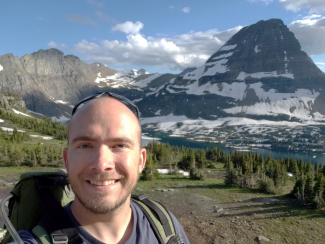Mike Kavulich grew up in suburban Connecticut, the oldest of three children with a younger brother and sister. From his earliest memories he had an obsession with the weather, giving weather reports to his class in preschool, watching and re-watching weather documentaries recorded from TV on VHS, and tracking hurricanes on a copied paper hurricane tracking map taped to the wooden basement door. Because he did not have cable or internet, he would call his grandmother every day of the late summer to turn on the Weather Channel at 10 minutes before the hour to get the latest coordinates for active tropical cyclones, marking their locations with pins on the hurricane tracking chart in his basement. At the age of 10, a summer thunderstorm downed trees across his town, and produced a brief tornado. Mapping the paths of each downed tree and limb in his backyard convinced him that the tornado had struck there too – though the National Weather Service never called for his consultation. With this knowledge in hand, it shouldn’t be a surprise that he always knew he wanted to study the weather. Though he achieved that dream, it turned out quite a bit different from how young Mike imagined it.
His high school physics teacher encouraged him to broaden his horizons beyond the atmosphere, so rather than taking a direct academic path to meteorology, he attended Worcester Polytechnic Institute in Massachusetts for a degree in Physics. Despite developing a learned love for all branches of physics, it was the atmosphere that kept drawing him back: he wrote his senior thesis on the physics of sand dune movement in the thin atmosphere of Mars. This led him to graduate studies at Texas A&M, where he studied the energy budget of storms in the Martian atmosphere, earning a masters in Atmospheric Science in 2011. After graduation, he was hired as an associate scientist in the NCAR Mesoscale and Microscale Meteorology Laboratory. There he worked on the WRF Data Assimilation (DA) project, creating documentation, tutorials, and eventually doing software development, not just for WRFDA but for the whole WRF system.
In 2017, Mike moved to the DTC as a member of NCAR’s Research Applications Laboratory (RAL) Joint Numerical Testbed, where he now works on a variety of projects related to the Unified Forecasting System, or UFS – the next generation of weather prediction models for NOAA. He develops and improves the software framework for the UFS as well as the individual components, contributing to the build system, the workflow, and the Common Community Physics Package used by the UFS weather model. While most of his job could more accurately be described as software engineering than meteorology, he is grateful to be immersed in such a weather-centric environment. In addition to water-cooler discussion with his more scientific colleagues, he is able to find an outlet for his meteorological pursuits by making his own forecasts for his hobbies of skiing, hiking, and storm chasing.
Mike is married to Dr. Christina Holt, a former DTC member herself, who now works at NOAA in the Global Systems Laboratory. The two of them have lived a nomadic lifestyle since May 2021, traveling the country and living and working out of their camper van, Vincent. In September 2022 they finished their goal of visiting all 48 states in the Continental US. In addition to countless other goals, they hope to eventually visit all 63 National Parks – or however many there are by the time they finish!

